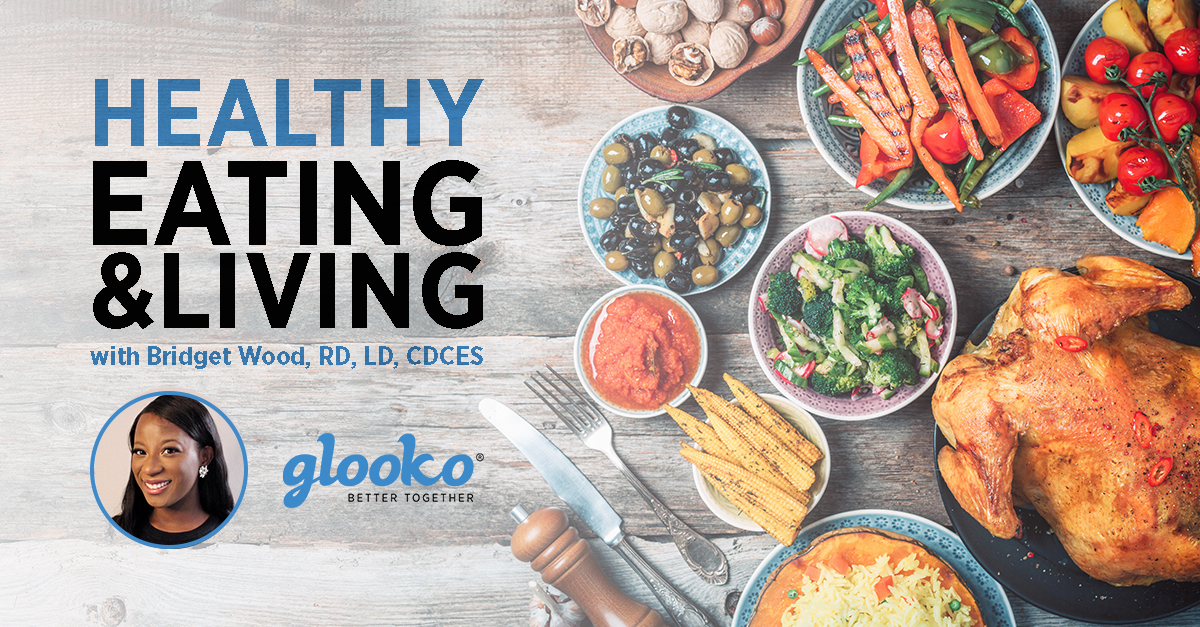
It’s hard to believe that my favorite time of the year is here again-the holidays! We’ve been working so hard all year towards the goals we set for ourselves earlier this year and now it’s time to relax, celebrate and enjoy family.
Last year we focused on tips like how to practice mindfulness during the holidays, but this year I figured we would focus on something that combines last year’s theme and the theme of sustainability.
Besides the actual holiday dinner feast, meals made with the leftovers from the holidays tend to be some of the things I look forward to most. Let’s face it-after meal 4 or 5 of the same exact thing, it starts to get old!
This year I’m focusing on something fun and providing you ideas for some blood sugar friendly meals to repurpose some of your holiday leftovers!
TURKEY
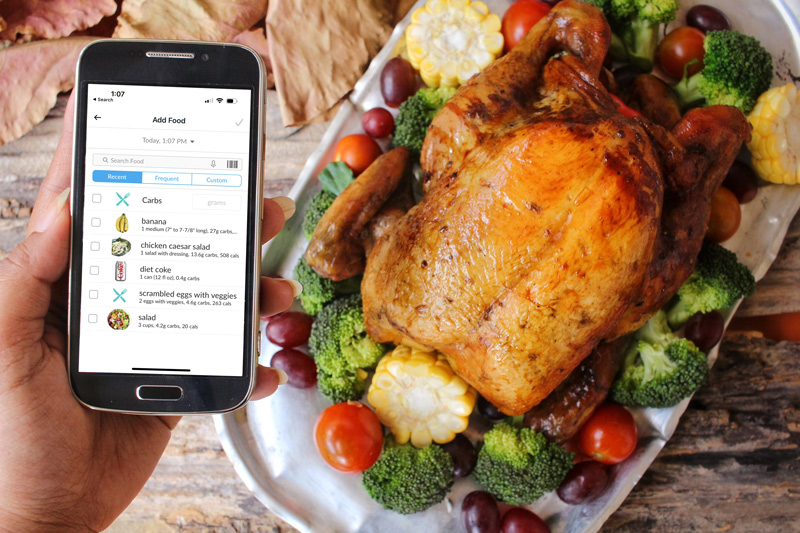
Turkey is the star of many holiday meals and can continue to be a protein packed base to a breakfast, lunch or even dinner, days after you first enjoy it with family.
Turkey is a lean protein and has about 25 grams of protein for a 3 oz serving of turkey breast. You can add leftover turkey to create:
Turkey Breakfast Hash: Chop up your leftover turkey and saute with bell peppers, onions, and leftover sweet potatoes for a fun breakfast the next morning, filled with fiber and flavor! Pair with eggs for a protein packed scramble.
Turkey Salad: Leftover turkey replaces chicken as the star for this holiday themed chicken salad alternative. Swap mayonnaise for plain low-fat greek yogurt for lower calories, fat and extra protein and add dried cranberries for a fun seasonal twist.
Mini Turkey Shepherd’s Pie: Your leftover turkey and mashed potatoes can be repurposed to make the perfect personal sized shepherd’s pies! Your leftover turkey is transformed with the addition of nutritious veggies like carrots, onions and celery and can be portioned into mini ramekins or mason jars to keep the portion size blood sugar friendly. Top the meat, veggie and gravy mixture with your leftover mashed potatoes-having them mini and pre portioned makes it easier to plan your meal dosing strategy!
SWEET POTATOES
As someone who is originally from the South, “sweet potato casserole” and yams hold a special place in my heart. While you can absolutely enjoy the regular tried and true versions of these during your holiday time with your family, there are several different ways you can repurpose your leftovers (if there’s any left!) into new blood sugar friendly traditions for you and your family to enjoy.
Try blending and using your leftover sweet potatoes as an addition to a seasonal smoothie, soup base, and even some high fiber sweet potato pancakes for the breakfast the morning after your holiday dinner to wow your guests! I recommend a protein pancake or homemade oat flour pancake recipe to keep it more blood sugar friendly.
Simply add the blended sweet potatoes to any of your favorite recipes.
CRANBERRY SAUCE
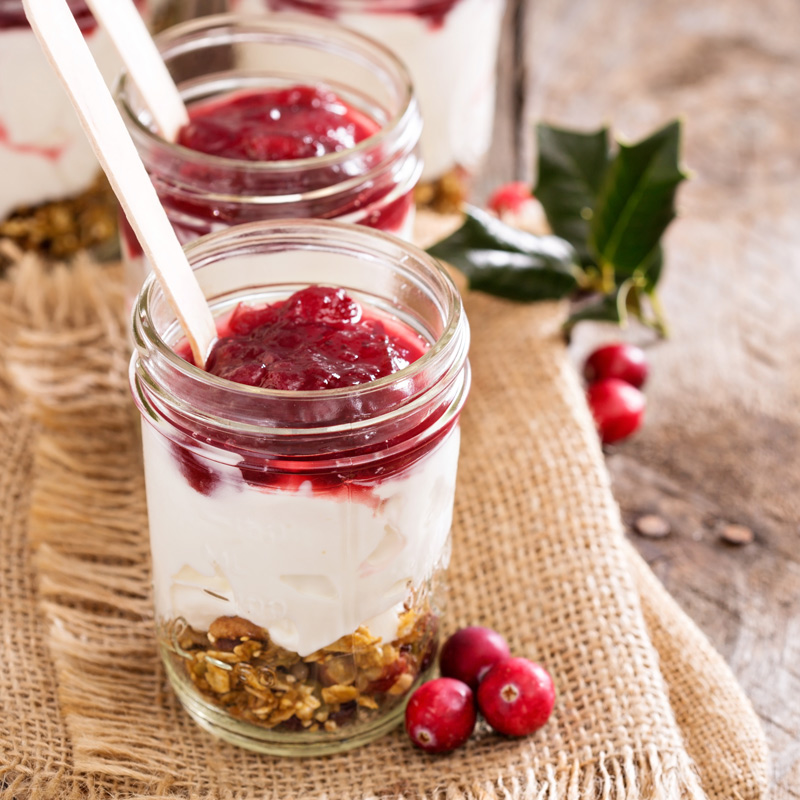
Whether it is homemade or store bought, cranberry sauce doesn’t have to be just a sidekick. Even canned cranberry sauce can be cooked down and added to low glycemic fruits like berries to make a topping for things such as greek yogurt parfaits, oatmeal, and desserts like fruit sorbet and homemade nice cream. By melting it down and adding low glycemic fruits to the cranberry sauce, you can minimize the amount of added sugars per serving while still enjoying the holiday flavor that you love!
Whether it be these new takes or your own creations, I hope you find creative ways to enjoy your holiday leftovers that won’t take away from the festivities due to battles with blood sugars. Make sure to use the food tracker, fitness activity tracking, and notes features on your Glooko Mobile App to make notes of all your food and diabetes related experiments-it will help to know what worked and what didn’t.
Don’t forget to tag Glooko in all of your creations and I hope you have a happy holiday season and find joy in all your holiday food adventures!
Season’s Eatings,
Bridget Wood, RD, LD, CDCES
MKT-0494 01
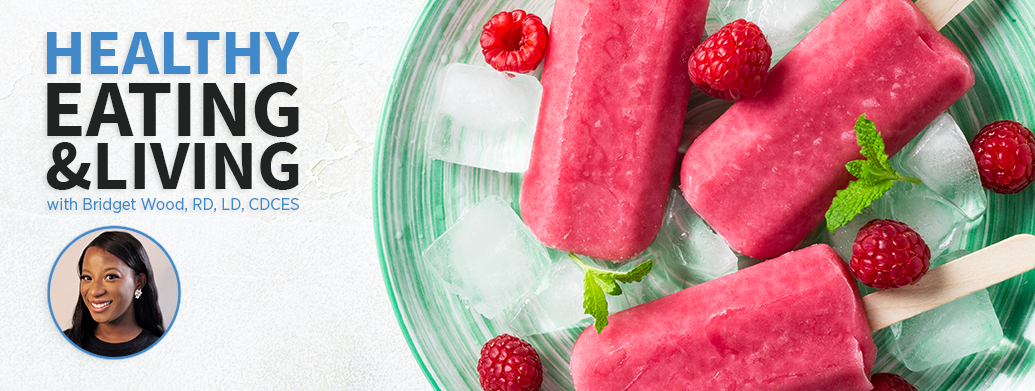
Summer is one of the best seasons for multiple reasons: we’re in full vacation mode, the sun is shining, the grills are sizzling and the beach is calling more often than not. There is only one not necessarily welcome thing that the summer brings…the heat!
Staying hydrated and avoiding being overheated is important for everyone, but it can be especially critical for people with diabetes and other related chronic conditions. Overheating can potentially lead to dehydration, which may impact your time in range. If you’re someone using insulin, it can get impacted if it’s left out in the heat for too long. Certain medications used for cholesterol and blood pressure management can also cause you to be more sensitive to the sun.
While your own personal care team can help you with solving some of these potential concerns, never fear your favorite RD is here with some tips that will help in the tastebud department and keep you cool all summer long!
FROZEN TREATS
Frozen treats are notorious for having lots of carbohydrates and sugar. While all foods can work for people with diabetes and related chronic conditions, it is important to discuss with your care team how to best moderate these and incorporate them into your own way of eating. Check out some typical frozen treat favorites and some diabetes friendly versions below!
Popsicles
In the grand scheme of things, popsicles aren’t really the highest carbohydrate frozen treat. You can make them even more nutritious by crafting your own with fruit and either a liquid of your choice or Greek yogurt and freezing in molds until ready to enjoy. The fruit will add some additional vitamins and Greek yogurt will add protein to the treat to keep you fuller and aid in stabilizing blood sugars.
Pro Tips:
- Make sure that when choosing your yogurt or liquid that you aim for foods with 10g of added sugar or less to promote a favorable blood sugar response.
- Try chocolate coconut water and chopped strawberries for a hydrating chocolate covered strawberry treat on the go!
Ice Cream, Smoothies and Sherbet
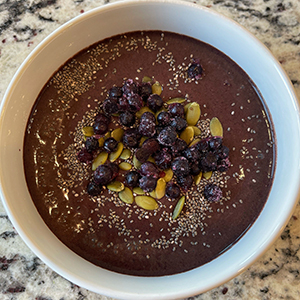 Ice cream is one of the most classic frozen treats around, but can be seen as a hard-to-bolus for food for some due to its high sugar and fat content. The high saturated fat can also be seen as a concern for those with chronic conditions such as high cholesterol.
Ice cream is one of the most classic frozen treats around, but can be seen as a hard-to-bolus for food for some due to its high sugar and fat content. The high saturated fat can also be seen as a concern for those with chronic conditions such as high cholesterol.
Grocery stores sell sugar-free or low carb ice creams, smoothies or sherbets, but it is even easier to just make it yourself at home! Typically, I have some form of unsweetened non-dairy milk (great for people on a vegan diet, but also low in carbs) and frozen fruit around for smoothies that can be repurposed to make sherbet. Dairy milk can also be used, but keep in mind that it can add more carbohydrates and dietary fat to the sherbet. As long as you have a high powered blender and 5 minutes, you can make your own treat in no time or effort!
Pro Tip:
- I usually add a sweetener, such as erythritol or monk fruit, to minimize the impact to my blood sugars without having to think about it. You can also use real sugar or honey as long as you are mindful of your portion sizes and the amount used.
Frozen Fruit
 As simple as this seems, frozen fruit is one of the most underrated frozen treats out there for people with diabetes. You can buy and store a large amount at a time, the fruit is frozen at its peak ripeness, and it’s so versatile! From freezing and enjoying as-is to adding to sparkling water for an ice cube that doubles as a snack, frozen fruit is definitely something that you can use to keep you cool, hydrated and meeting your personal fiber goals.
As simple as this seems, frozen fruit is one of the most underrated frozen treats out there for people with diabetes. You can buy and store a large amount at a time, the fruit is frozen at its peak ripeness, and it’s so versatile! From freezing and enjoying as-is to adding to sparkling water for an ice cube that doubles as a snack, frozen fruit is definitely something that you can use to keep you cool, hydrated and meeting your personal fiber goals.
Pro Tip:
- You can also freeze fresh fruit, especially those that have been hanging out in your fridge for a couple weeks! Watermelon is especially a great choice for this as its water content is more than 90%. Just blend fresh watermelon cubes and place in an ice cube mold. Freeze until solid and you have a natural popsicle, or a fun addition to your sparkling water or low carb summer cocktails. The watermelon cube eventually melts and transforms the beverage into something more fun and substantial. Remember to talk to your healthcare provider about incorporating alcoholic beverages before trying this one out though!
While you can have a slice of ice cream cake and eat it too, the simple swaps above can help to keep you beat the heat and help you conquer your diabetes and related chronic conditions during these summer months!
Here’s a recipe to also keep you cool this summer. This smoothie bowl recipe is packed with heart healthy ingredients and can easily be transformed into a refreshing acaí sorbet. Just add a lower sugar or plain yogurt to help increase thickness and creaminess!
Smoothie Bowl Recipe (PDF)
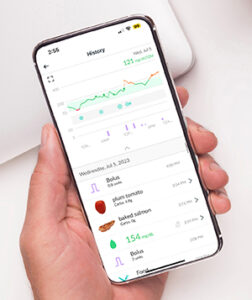 Be sure to track your food intake and write down the recipes for your creations in the notes section of the recently redesigned Glooko® Mobile App. You can share the data with your provider and tweak the recipe to continue to improve the response it has for you.
Be sure to track your food intake and write down the recipes for your creations in the notes section of the recently redesigned Glooko® Mobile App. You can share the data with your provider and tweak the recipe to continue to improve the response it has for you.
Don’t forget to tag @Glooko or myself (@BalancedWithBridgetWood) on Instagram, and use the hashtags, #BetterTogether and #BalancedWithBridgetWood, to showcase your fabulous frozen treats!
Stay cool (and hydrated!),
Bridget Wood, RD, LD, CDCES
MKT-0481 01
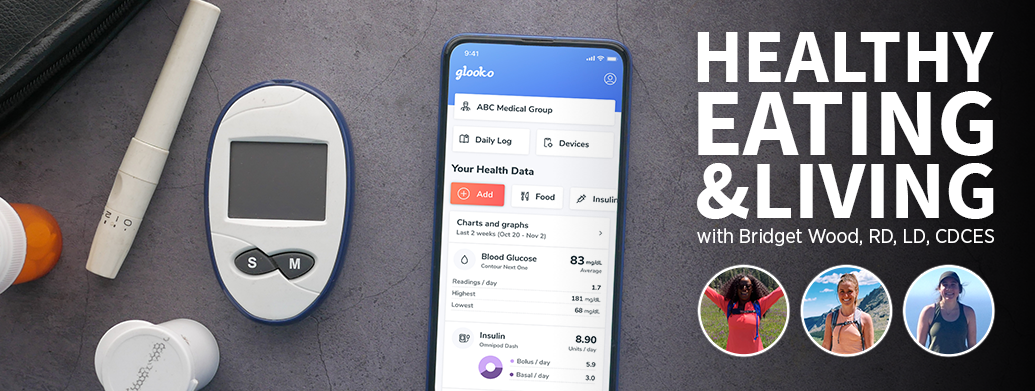
This month, we’re celebrating diabesties, people with diabetes who understand your experiences living with the chronic condition.
As you know, I’m fully immersed in the world of diabetes, whether it’s my experience as an RD and diabetes educator or my experience working for a diabetes company, I definitely can get my fair share of all things diabetes.
With that said, my most memorable experiences and friendships have come from being a part of the diabetes online community. You can find healthcare providers, organizations and other peers all living with diabetes all around the world. There is nothing more uniting than someone else who “gets it” and in the words of my friends here at Glooko, we certainly are better together.
Watch my conversation with two of my diabesties at Glooko, Clinical Trial Specialist Sam Rapp and Senior Partner Manager Hadley Horton, as we cover how and when they were diagnosed, how they manage their diabetes, how Glooko makes their day-to-day easier, what they wish people without diabetes knew about living with the chronic condition and what their favorite hard-to-bolus food is.
Check out some resources below to help find your own diabesties online or in person near you.
- Local American Diabetes Association (ADA) offices
- College Diabetes Network
- JDRF Online Diabetes Support Team
- JDRF TypeOneNation
- Diabetes Camps (for all ages!)
- Beyond Type 1
- Beyond Type 2
- diatribe
- T1D Exchange
Your friend in food and health,
Bridget Wood, RD, LD, CDCES
MKT-0469
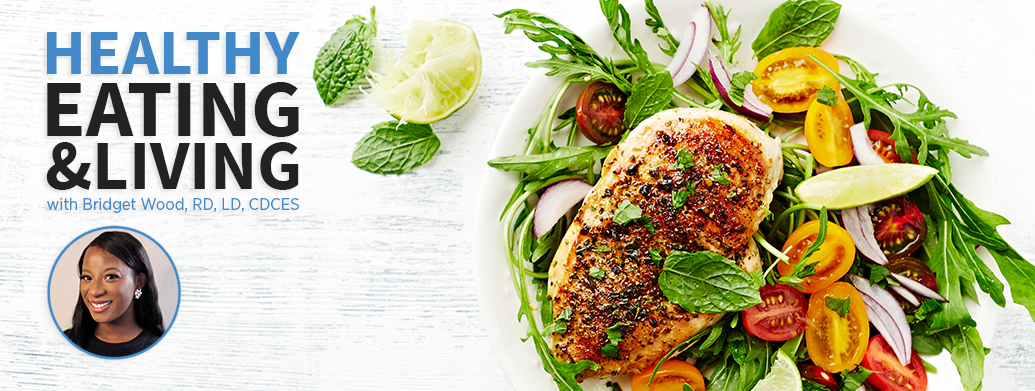
Happy National Salad Month!
This month, I’ll walk you through how to make a satisfying Mediterranean style salad that has ingredients that are very friendly to people living with diabetes and related chronic conditions.
Once you’ve enjoyed our video on making a healthy filling salad, check out these highlights:
- Plate Planning Method from the American Diabetes Association
- Mediterranean Style Salad Recipe (PDF)
- Dietary Fat Induced High Blood Sugars (Hyperglycemia): When consuming dietary fats, the rate of digestion is usually slowed down. While this can sometimes aid in stabilizing blood glucose levels, if the fat is consumed in excess it can delay the digestion of the meal enough that your insulin dosed at the start of the meal will no longer cover the meal (ask your provider about split or extended boluses to fix this) and increase insulin resistance for hours and cause a release of hepatic (liver) glucose due to the high amounts of fat present in the meal. While this typically would not occur in meals like a salad, it’s important to be mindful of portion sizes and dietary fat sources so that you can adjust your regimen accordingly to minimize spiking. You can even use the newly redesigned Glooko® Mobile App to take notes of which foods create this response and track what works best for you to avoid it.
After crafting your own salad, be sure to tag @Glooko or myself (@BalancedWithBridgetWood) on Instagram, and use the hashtags, #BetterTogether and #BalancedWithBridgetWood, to showcase your satisfying creations.
Your friend in food (and diabetes),
Bridget Wood, RD, LD, CDCES
MKT-0459

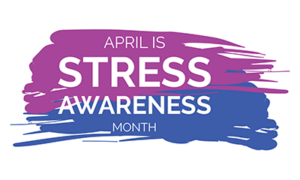
Picture this: it’s Tuesday and you start off your day the way you typically would. You wake up and go for a 30-minute walk before work, eat your typical lunch at your typical lunch time, and make sure to drink water throughout the day for your hydration. On any other Tuesday, these are typically the tools you have employed to promote blood sugars that are in range. Except for some reason, today is different…you check your blood sugar before leaving the office for a 3:30 pm dental appointment and it reads 250 mg/dl.
You start to experience more stress, but treat your high blood sugar according to your treatment plan and two hours later, your blood sugar reads 265 mg/dl.
But why?
If you’re looking for answers, you’ve come to the right place. Welcome to this month’s blog post about stress and diabetes in honor of Stress Awareness Month.
STRESS AND ITS IMPACT ON BLOOD SUGARS
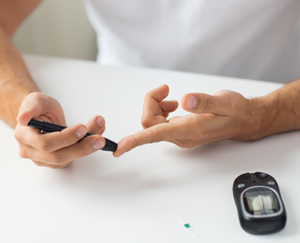 When you experience stress, your body releases hormones, such as cortisol and adrenaline. These hormones trigger the liver to release glucose into your bloodstream, which your body then uses for energy in response to the stress (aka the fight-or-flight response).
When you experience stress, your body releases hormones, such as cortisol and adrenaline. These hormones trigger the liver to release glucose into your bloodstream, which your body then uses for energy in response to the stress (aka the fight-or-flight response).
This can be helpful for some people as it provides them with the energy they need to take on the stressor. For people with diabetes, it can lead to increased blood sugar levels and insulin resistance as their bodies may not produce enough insulin (or any at all) to regulate the new increase in glucose levels. These hormones also can prevent the insulin your body is producing, or you are taking, from working as they normally would—making it even more difficult to return to your baseline.
TYPES OF STRESS
Now that you know how stress can impact your body and diabetes management…did you know there are different types of stress?
Physical stress refers to the physiological or biological demands placed on the body that require it to adapt to a new or challenging environment. Physical stress can come from a variety of things such as exercise, illness, or injury.
Mental stress refers to the psychological and emotional demands placed on an individual that can lead to feelings of strain or tension. Mental stress can come from a variety of things such as work, school, relationships, financial concerns, or health issues.
While both of these types of stress can develop quickly and resolve (acute), they can also be chronic (long-term) and lead to a range of other long-term issues with blood pressure, cardiovascular disease, insulin resistance, mental health, sleep, and your ability to care for your diabetes. It is also worth noting that stress can also be either positive or negative, so something like planning a vacation, wedding or new job can impact your stress levels in a similar way to a traumatic event like going to the dentist can.
Even positive stress can become negative if it becomes too overwhelming or persistent. The best way to counteract the impacts of stress on your body is learning the best ways for you to cope with the stress. Learning to manage stress through self-care practices and seeking support when needed from your community or care team can help to maintain a healthy balance of stress and reduce its impacts on your health.
SYMPTOMS OF STRESS
According to Healthline, these are the symptoms of stress:
Physical symptoms:
-
headaches
-
muscle pain or tension
-
sleeping too much or too little
-
general feelings of illness
-
fatigue
Mental symptoms:
-
feeling unmotivated
-
feeling irritable
-
feeling depressed
-
feeling restless
-
feeling anxious
Stress can also cause you to exhibit behavior that is not typical for your day-to-day, including:
-
withdrawing from friends and family
-
eating too much or too little (which can impact blood sugar levels!)
-
acting out in anger
-
drinking alcohol to excess (which can also impact blood sugar levels!)
-
using tobacco (nicotine can raise blood sugar levels)
Knowing what to look out for can help you react and practice the best self-care routine or coping mechanisms for you!
WAYS TO RELIEVE STRESS
 Some people find that doing things like moving their bodies on a regular basis, eating nourishing foods that foster and benefit mental health, practicing relaxation methods and breathing techniques, stretching, listening to music, or meditation can help them manage their stress levels in an optimal way.
Some people find that doing things like moving their bodies on a regular basis, eating nourishing foods that foster and benefit mental health, practicing relaxation methods and breathing techniques, stretching, listening to music, or meditation can help them manage their stress levels in an optimal way.
Others may find success in seeking social support from friends and family or their online community. Personally, I like to use a combination of these tactics to help minimize the impact of stress on my body and diabetes management. You can also work with your team to have a “sick day” plan or regimen to help counteract the insulin resistance you may be experiencing.
If you’re looking for a good place to start destressing, check out resources from these leading organizations:
-
Connected In Motion Slipstreams (Virtual and In-Person)
-
Insulin Inclusive (Diversity in Diabetes, Risely Health and BlackDiabeticGirl)
-
American Diabetes Association’s Mental Health Care Provider Directory
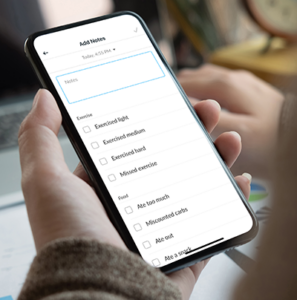 Stress is another factor that can impact blood sugar levels, but making sure that we have the correct tools in our tool belt needed can help minimize its effects on our blood sugars and diabetes management. Choose one method or a few from the above suggestions and observe how these impact your stress levels.
Stress is another factor that can impact blood sugar levels, but making sure that we have the correct tools in our tool belt needed can help minimize its effects on our blood sugars and diabetes management. Choose one method or a few from the above suggestions and observe how these impact your stress levels.
Make it a point to take notes in your Glooko Mobile App whenever you are experiencing stressful situations and track how the methods are working for you, so you can discuss with your provider at your next visit!
Your friend in food (and diabetes),
Bridget Wood, RD, LD, CDCES
In honor of the 50th anniversary of the Association of Diabetes Care and Education Specialists (ADCES), Glooko’s very own Bridget Wood, RD, LD, CDCES was recognized as a featured member. Check out an article highlighting her work advancing diabetes care and education.
MKT-0447 01
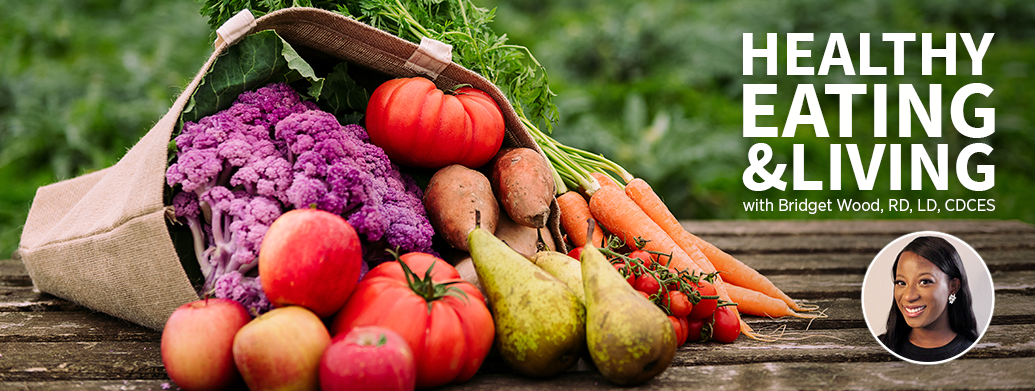
Hello and happy spring!
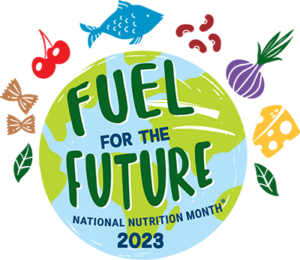 I hope you’ve been working hard on those goals that we set at the beginning of the year! The great thing about goal setting is that they can always be adjusted and evaluated throughout the year!
I hope you’ve been working hard on those goals that we set at the beginning of the year! The great thing about goal setting is that they can always be adjusted and evaluated throughout the year!
Personally, March is one of my favorite months. It not only marks the beginning of spring and (hopefully) the transition to sunshine and warmer weather, but it is also National Nutrition Month! This year’s theme is “Fuel for the Future,” which not only encourages people to make informed food choices that support their long-term health and well-being, but it also encourages people to make sustainable food choices that support environmental health and reduce the impact of food production on the planet.
Simply put by the Harvard T.H. Chan School of Public Health, sustainability is when we “meet needs of the present without compromising the ability of future generations to meet their own needs.”
Making sustainable nutrition choices involves considering not only the nutritional value of the food you eat, but also the impact that the production, transportation and disposal of that food has on the environment. Believe it or not, you can actually tie in sustainable food choices with your diabetes management.
Let’s take a deeper look at some basic ways to do that and use your Glooko mobile app along the way!
CHOOSE PLANT-BASED FOODS
![]() Plant-based foods such as fruits, vegetables, whole grains and legumes have a smaller carbon footprint compared to animal-based foods. This is because plant-based foods require fewer resources to produce and transport. They also aid in managing blood sugar levels and overall health as they are typically good sources of fiber, vitamins, minerals and antioxidants. Plant-based diets can help improve glycemic control, reduce risks for heart disease, and even prevent Type 2 diabetes.
Plant-based foods such as fruits, vegetables, whole grains and legumes have a smaller carbon footprint compared to animal-based foods. This is because plant-based foods require fewer resources to produce and transport. They also aid in managing blood sugar levels and overall health as they are typically good sources of fiber, vitamins, minerals and antioxidants. Plant-based diets can help improve glycemic control, reduce risks for heart disease, and even prevent Type 2 diabetes.
Try tracking your plant consumption in the food tracker in the Glooko mobile app to help identify where you can adjust your intake of these beneficial foods.
EAT LOCAL AND SEASONAL FOODS
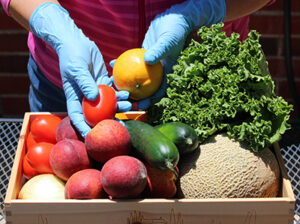 Eating foods that are in season and locally grown can help reduce the carbon emissions associated with transportation. Additionally, local foods are often cheaper, fresher and may be more nutritious than foods that have traveled long distances.
Eating foods that are in season and locally grown can help reduce the carbon emissions associated with transportation. Additionally, local foods are often cheaper, fresher and may be more nutritious than foods that have traveled long distances.
Look for farmer’s markets or Community Supported Agriculture (CSA) programs in your area as they can be an affordable and fun way to try produce you haven’t tried before.
REDUCE FOOD WASTE
Food waste contributes to greenhouse gas emissions, so it’s important to minimize the amount of food that isn’t consumed. In fact, roughly one-third of all food produced globally is wasted.
By planning your meals ahead of time, storing food properly and using leftovers to make new meals—you can help do your part. Planning ahead can also lead to more stable blood glucose levels as you have time to address the best dosing strategy, assess any physical activity impacts, and have an overall better prediction of how blood sugars are going to react to the meals (although sometimes things react differently than we would expect, and that’s okay).
I’ll admit that despite my best efforts sometimes the vegetables and salad that I purchase don’t get the best attention. With rising food prices, throwing things away is not an option…not to mention it’s not good for sustainability!
REDUCE MEAT CONSUMPTION
Meat production has a high environmental impact, particularly when it comes to greenhouse gas emissions. You don’t have to go fully vegetarian or vegan, but reducing your meat consumption can help reduce your carbon footprint AND increase your time in range. By reducing your meat consumption and opting for more plant-based foods, you can increase your intake of complex carbohydrates, which promote blood sugar stabilization.
The high saturated fat found in meats can also increase your risk of heart disease when consumed in excess. Recent studies have also shown potential links to certain proteins in red meats may increase the risk of heart disease as well. According to the CDC, people with diabetes are twice as likely to have heart disease or a stroke than people without diabetes, so taking all of the steps to reduce consumption in the name of prevention is a win in my book!
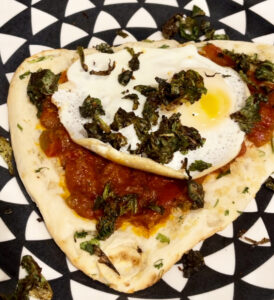
And don’t forget that the Glooko mobile app is compatible with many leading smart blood pressure cuffs to monitor and track progress in lowering blood pressure over time.
By making sustainable nutrition choices, you promote better health and wellness for yourself and future generations. Try one (or all) of the steps above to “fuel your future” and check out more ways to do so from EatRight.
Need more inspiration? Check out my quick recipe for a Shakshuka Naan Pizza (PDF) using greens that were about to expire! This delicious naan pizza recipe uses those wilted greens that often find themselves in the trash and gives them a new life.
Your friend in food,
Bridget Wood, RD, LD, CDCES
MKT-0430 01
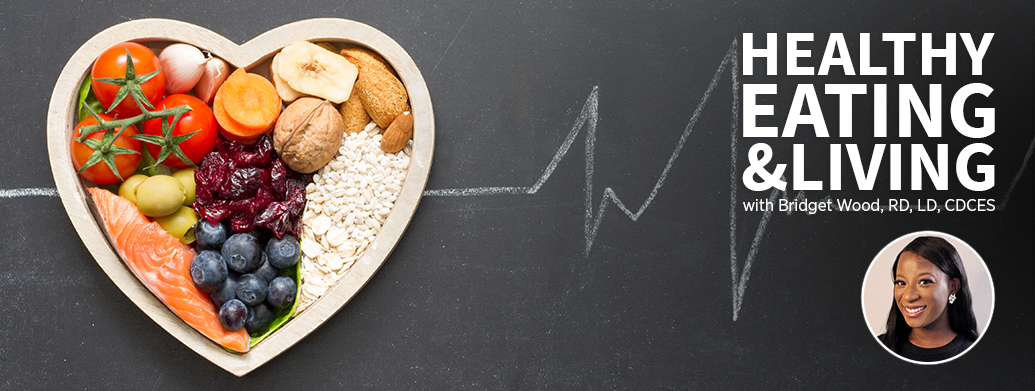
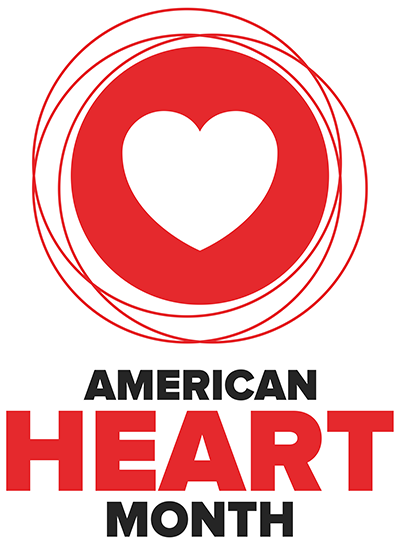
Hard to believe that another month is gone and we’re well into the swing of things in 2023!
While it is important to prioritize heart health every month of the year, February is special as it is American Heart Month and helps to call awareness to heart disease, the leading cause of death for people living in the United States. Data shows that a person dies every 34 seconds from heart disease.
According to the CDC, people with diabetes are twice as likely to have heart disease or a stroke than someone who doesn’t have diabetes. People with diabetes are also more likely to experience heart failure.
While some people may have an increased risk due to having a higher genetic predisposition to certain heart conditions, such as high cholesterol and blood pressure, we can all take steps to reduce our risks by doing things like increasing physical activity, quitting smoking (if you’re having trouble quitting, try this free app from the FDA and National Cancer Institute), keeping A1c and time in range at goal and by eating a diet filled with heart healthy foods. Most importantly, get tested for heart disease and take care of your heart.
In some cases, these lifestyle changes can help to prevent heart disease altogether. Let’s take a look at some of the more unique (and budget friendly) cardiovascular friendly foods you can add to your plate to support optimal heart health.
FISH

Fish has long been touted as one of the best heart healthy foods for people looking to increase their cardiovascular health. It is a source of a type of unsaturated fat called Omega-3 fatty acids (or Omega-3), which has been linked to a reduced risk of heart disease and improved brain health. It also may positively impact mental health and sleep quality, which can both increase risk of heart disease if not managed properly.
The problem with fish? It can be expensive and not everyone likes the taste! As food costs rise, fresh fish might not always be the most feasible option for your weekday menu.
To keep the grocery bill lower, I recommend looking at your local grocer to see what sales they might have or my personal favorite, canned fish! Canned fish used to get a bad reputation due to the potential high sodium content and mercury, a toxin to all but one that can be especially dangerous for people who are pregnant. Today, brands, such as SafeCatch and WildPlanet, have gotten much better at reducing these amounts by testing every fish and offering salt free options. You can keep it simple by enjoying it as a snack, adding it to a salad, or making it a meal that the entire family can enjoy as fish cakes or nuggets!
BEANS
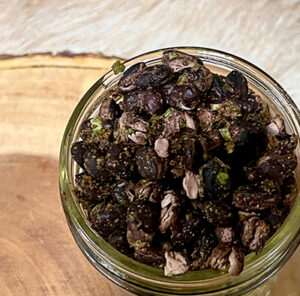 As a self-proclaimed advocate of all things beans, I cannot stress enough how beneficial they can be to your health. They are a cheap source of protein, can be purchased without sodium, and are shelf stable so they’re readily available for you at any time!
As a self-proclaimed advocate of all things beans, I cannot stress enough how beneficial they can be to your health. They are a cheap source of protein, can be purchased without sodium, and are shelf stable so they’re readily available for you at any time!
I’ve spoken about how their high fiber content can help to improve heart health, but they also contain minerals such as folate and magnesium, which are not only good for your heart, but also may help with blood sugar management. Beans are also resistant starches, a specific type of carbohydrate that is not digested by the body. Resistant starches have not only been linked to improved heart health, but also more favorable blood sugars and stability. Try making your own bean dip to enjoy with fresh vegetables or making crunchy these air-fried beans as a snack.
And don’t judge this snack by its looks! Similar to the crispy chickpeas you can find in the grocery store, this quick, cheap and easy snack can be a great source of protein, fiber and flavor! Bean poppers, as we call them in the Wood household, can be a unique way to enjoy heart healthy beans.
Air Fried “Bean Poppers” Recipe (PDF)
POPCORN
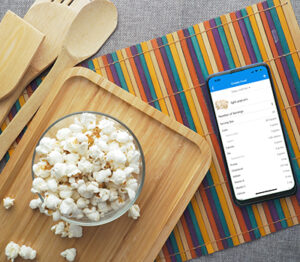
My patients are always surprised whenever they hear me recommend popcorn as a great snack for people with diabetes. Popcorn is a whole grain and is a good source of heart healthy fiber, but did you know that it also is a source of antioxidants that may help to prevent heart disease? We often think of movie theater popcorn, which has a ton of sodium and butter, both things that can impact your heart health negatively. However, popcorn that you make at home can be a fantastic heart healthy (and affordable!) snack.
If you have a popcorn popper at home, you can use this to make a batch…or air pop your own on the stove or microwave, my personal favorite method. You don’t need to add oil, which not only helps reduce the caloric amount for those managing their weight, but also helps to reduce the negative impact on heart health! You can keep sodium levels managed by reducing the amount of salt you use to flavor the popcorn or by using a salt free seasoning to spice things up. My personal favorite way to enjoy it is with a little bit of salt and nutritional yeast, a vegan cheese substitute that is full of B vitamins and antioxidants that may also help to reduce heart disease.
Along with the foods mentioned above, increasing your intake of fruits, vegetables and fiber rich foods such as whole grains can also contribute to a lower risk of heart disease. You also want to be mindful of your consumption of sodium and saturated fat-laden red meats as this can also increase your risk. While you don’t have to eliminate the consumption of these foods entirely, you will help to protect your heart by limiting them to a few times a week.
Make it a goal to try incorporating one of the foods mentioned above at least once a week or use the American Heart Association’s Digital Grocery List when planning meals to jumpstart your new journey to a healthier heart.
You can even use the food tracker feature in your Glooko mobile app to help you every step of the way by tracking your exercise, food, blood pressure and more. I’m always looking at my data and being able to view my History on the app alongside my blood glucose data has been a tremendous help to identify patterns—I hope it can do the same for you!
Your friend in food,
Bridget Wood, RD, LD, CDCES
MKT-0428 01
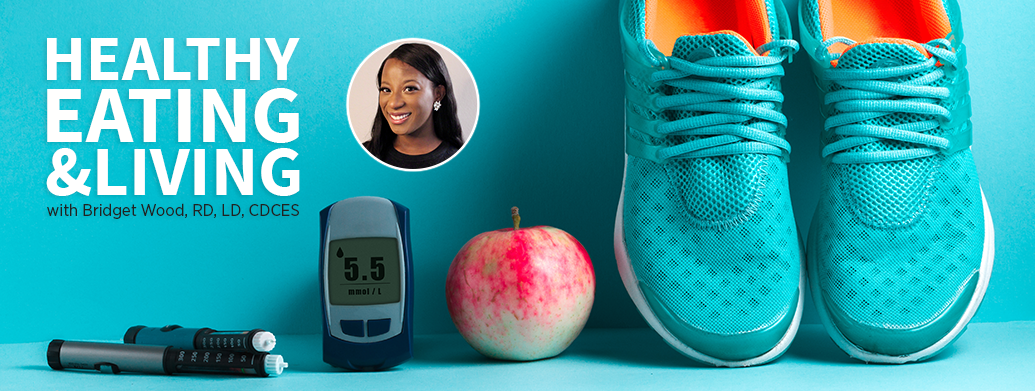
Hello and Happy New Year!
It’s no secret that the New Year is seen as a clean slate and a chance to start fresh for most people. You can see the evidence everywhere—there’s more people in the gym, eating “healthy foods” and trying new things to promote better wellness.
A survey conducted by Forbes Health/OnePoll found that 39% of their respondents wanted to improve fitness, 37% wanted to lose weight and 33% hoped to improve their diet in the new year. Unfortunately, despite having all of this optimism, another survey from Urban Plates/Ipsos found that most people keep their resolutions for less than a year, with only 11% lasting for more than 6 months. But why?
Let’s dive deeper into wellness goal setting and how you can set attainable goals that you can be guaranteed to keep this year—and many more to come!
S.M.A.R.T. GOALS
When setting a goal, most people choose what they want to achieve and go for it!
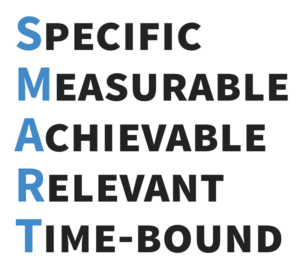
While this can be successful for some people, most might find themselves going back to old habits sooner than they would like. By setting a specific goal or using the S.M.A.R.T. goal method, you can increase your chances of obtaining your wellness wins as you’re essentially creating a plan to help you succeed.
A smart goal is Specific, Measurable, Achievable, Relevant and Time-Bound.
It can be a way to really target your goal setting (and is something I use with my clients as a registered dietitian!). When we look at typical wellness goals, most aren’t specific. Usually someone says they want to be healthier or exercise more…but HOW will they achieve these things?
A S.M.A.R.T. goal in this realm would be something like, “I would like to increase my intake of nutrient dense foods by eating a serving of fruit and non-starchy vegetables at two meals a day, three days out of the week” or “I would like to incorporate 10 minutes of cardio by walking 3 days out of the week on my lunch break.”
When a goal is more achievable and relevant to you, you are more likely to achieve it and move to the next steps in your wellness journey.
OTHER WAYS TO ACHIEVE YOUR GOALS
While S.M.A.R.T. goals are a great way to help ensure success, they are not the only method you can use to help!
Let’s dive deeper into some of the other ways you can help meet your goals.
Write them down
Writing your goals down in a visible or safe place can help serve as gentle motivation to help you reach your goals. Studies have shown that people who write down their goals and dreams on a regular basis are 42% more likely to achieve them!
Find your tribe
I cannot stress enough how beneficial having an accountability partner or group can be when starting a new wellness journey or new diabetes goal. It can be something as simple as creating a channel on Slack to share new recipe ideas with coworkers or finding an online diabetes community such as Connected in Motion, Risely Health, Dope Diabetic Girls, YourDiabetesInsider, or Diversity in Diabetes. Not only will they be able to empathize with what you’re going through, but they often have peer shared resources or free events by healthcare providers that can be beneficial to keeping you on track.
Start off slow
 This is the biggest barrier I see when it comes to goals and clients. People are excited to make a change and hit the ground running, but may bite off more than they can chew (no pun intended!). If you’re someone who doesn’t exercise, going to the gym and running on the treadmill may not be sustainable. It’s just like someone who doesn’t usually eat vegetables would not likely maintain their new goal of “eating salads every day at lunch.” Try to make your goal something that you know you can achieve such as trying a new non-starchy veggie every two weeks or going for a walk as a mental health break during the day.
This is the biggest barrier I see when it comes to goals and clients. People are excited to make a change and hit the ground running, but may bite off more than they can chew (no pun intended!). If you’re someone who doesn’t exercise, going to the gym and running on the treadmill may not be sustainable. It’s just like someone who doesn’t usually eat vegetables would not likely maintain their new goal of “eating salads every day at lunch.” Try to make your goal something that you know you can achieve such as trying a new non-starchy veggie every two weeks or going for a walk as a mental health break during the day.
Don’t forget you can track your activity on the Glooko mobile app! You can put your fitness tracker you got gifted over the holidays to excellent use as Glooko is compatible with many popular fitness and biometric devices.
You can also keep track of what new veggies you’re trying by logging in our food tracker within the Glooko mobile app and using the notes feature to remember which veggies you loved (and which you didn’t!).
DON’T BEAT YOURSELF UP
Lastly, don’t beat yourself up. People with diabetes are already making at least 180 more decisions each day than those who are not living with diabetes, so to add something new on top of that can be extremely challenging!
I always like to set a check in point with my goals or when helping clients set goals. This allows you to reflect on what worked and what didn’t after a month or six months. Once you know what didn’t work, try to brainstorm ways to eliminate these barriers to make it work better for you.
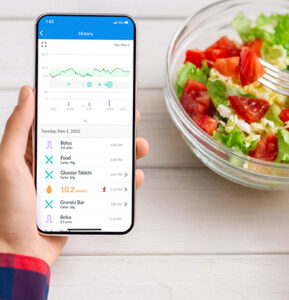 When it’s a diabetes related goal, diabetes management looks and works differently for everyone. It can feel disappointing at first, but know that you’re not alone. Tools, such as the insulin logging feature and medication logging feature on the Glooko mobile app, can help you with adhering to your prescribed medication regimen, can help to empower you to discover dosing strategies when looking to increase your time in range, and can help your healthcare team tailor your care plan as they have access to the data too!
When it’s a diabetes related goal, diabetes management looks and works differently for everyone. It can feel disappointing at first, but know that you’re not alone. Tools, such as the insulin logging feature and medication logging feature on the Glooko mobile app, can help you with adhering to your prescribed medication regimen, can help to empower you to discover dosing strategies when looking to increase your time in range, and can help your healthcare team tailor your care plan as they have access to the data too!
Small changes lead to big results, but most importantly you got this! I’ll be reminding you to check in on your goals in a few months, but I’ll like to leave you with an easy goal to achieve this year before next month…Goal #1: download the Glooko mobile app in the App Store and Google Play Store.
Your friend in food,
Bridget Wood, RD, LD, CDCES
MKT-0420 01
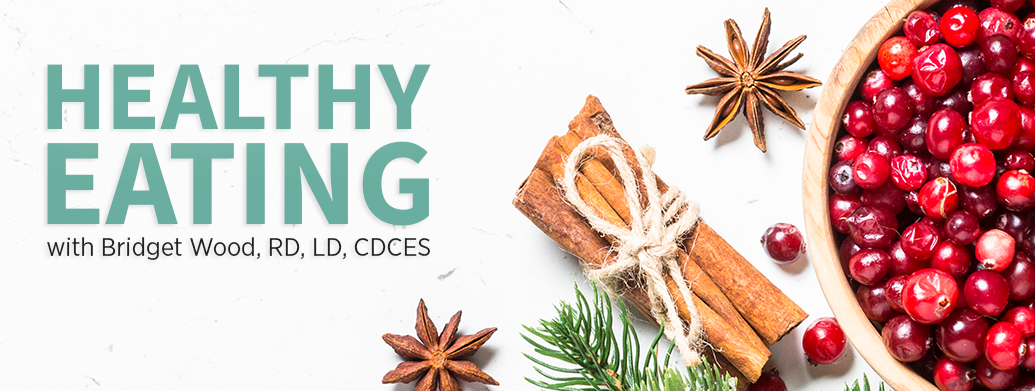
 The holidays have always been one of my favorite times of the year. For me, it always involves family and friends coming together surrounded by my favorite thing—food!
The holidays have always been one of my favorite times of the year. For me, it always involves family and friends coming together surrounded by my favorite thing—food!
After I was diagnosed with type one diabetes, it still remained my favorite season. The love has never gone away or changed, but the role my diabetes plays definitely has.
I’ve gone from the out of sight out of mind approach to having low carb alternatives for every holiday meal to finally being able to both enjoy the holidays and be able to be mindful of my numbers. You can try all of the tips below or even just choose one at a time until you feel like you’ve mastered it!
Be Mindful of Movement
 It’s difficult to prioritize movement in the colder months, but it really can be one of the best tools you can use to help keep your numbers in range. Physical activity can not only be a great way to get a change of scenery with your loved ones, but can help with lowering any insulin resistance that may be occurring from any high fat and high carb meals you’re having.
It’s difficult to prioritize movement in the colder months, but it really can be one of the best tools you can use to help keep your numbers in range. Physical activity can not only be a great way to get a change of scenery with your loved ones, but can help with lowering any insulin resistance that may be occurring from any high fat and high carb meals you’re having.
It can also help with digestion and to supercharge any insulin on board you have for a meal or stubborn high blood sugar.
Have a Plan
Just like with any special event and your diabetes, you want to have a plan. Diabetes is not one size fits all—and neither will be your approach to the holidays!
If you know the menu, you can try and plan a dosing strategy or bring a dish or entree that you have experience successfully dosing for to ensure you’ll have a safe option. Some people like to trial foods prior to the holiday, so they are prepared when the actual holiday comes. You can also use the Glooko food tracker combined with your glucose data in our digital health app to do this or to help you come up with a dosing strategy.
Others like to just go along with their day as usual and use it as a future learning tool for holidays and festive parties. The important thing to remember is that despite the outcome—you aren’t a failure! It is just one day, one time of the year, and tomorrow is a new day.
Perfect your Plate
The plate planning method is a great tool to use when planning meals all year round, but especially during the holidays!
By making sure you’re balancing your plate, you’re combining the carbohydrates you’re consuming with the protein and fat in the meal to create a great outcome when it comes to how your body is digesting the food. When we “clothe the carbohydrates,” we can help to reduce spiking post meals. With that being said, too much of an item can delay digestion too much and create spiking hours later, so aim for ¼ plate protein, ¼ plate carbohydrates and the remainder being a vegetable.
Here’s a pro tip: Try to aim for vegetables with a higher fiber content for a boost in blood sugar stabilization and minimize spikes.
Use Helpful Diabetes Tools
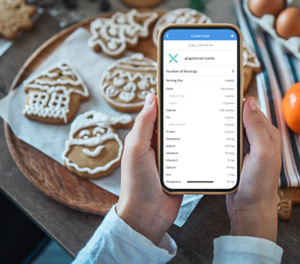 Technology can be our best friend when it comes to tackling the holidays.
Technology can be our best friend when it comes to tackling the holidays.
Don’t forget to use the food tracking feature in the Glooko mobile app to help you figure out the best carbohydrate amounts for your meals. Try to look items up ahead of time so that you’re prepared going into your meal. You can even go back and review your data after the holidays have passed so that you can make adjustments to your plan.
A fitness tracker can help you see your activity levels and be a gentle reminder to increase your movement if you’re dealing with stubborn highs. Many different fitness devices are even compatible with Glooko, which by connecting your device allows you to see all your data in one place.
Remember, it’s only Temporary!
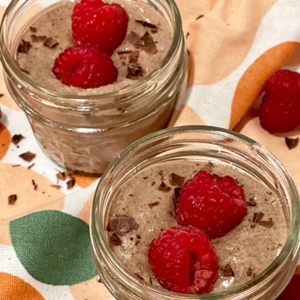 It’s just one day or one season.
It’s just one day or one season.
Blood sugar spikes can happen any time, but the holidays and time spent with your family do not. Blood sugars are going to fluctuate during the day regardless and sometimes the added stress of worrying about blood sugars can make any insulin resistance you’re experiencing from decreased movement worse.
And if you’re looking for a tasty treat that is blood sugar friendly, I’ve got one for you! This chocolate chia pudding can do triple duty as a breakfast item, snack or even a dessert! Chia seeds have a low impact on blood sugar levels (thanks to lots of fiber!) and can be extremely filling for a small amount. Some people don’t like the texture, which is understandable! You can get around this by blending it up until it is smooth.
Double Chocolate Chia Pudding Recipe (PDF)
No matter the outcome of your festive treat feats—I hope you have a happy holiday season and find the food tracker feature in Glooko helpful in all your holiday food adventures!
See you next year!
Bridget Wood, RD, LD, CDCES
MKT-0415 01
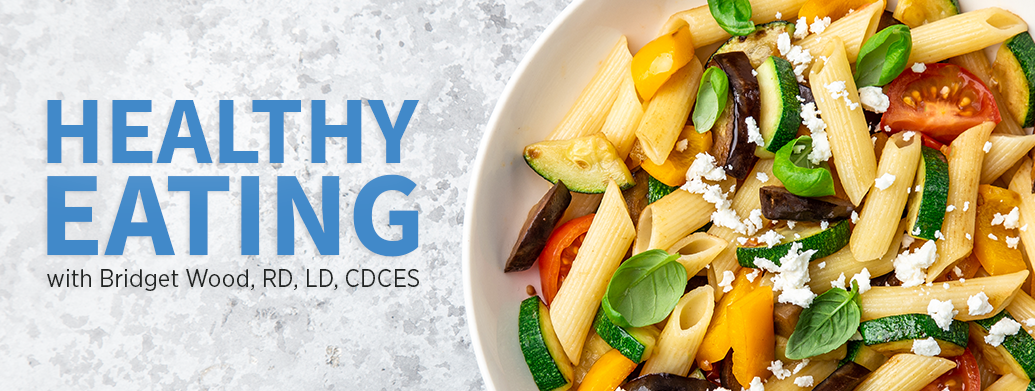
 As your friendly neighborhood registered dietitian nutritionist, diabetes educator and type one diabetes buddy, I couldn’t possibly write this post without saying Happy National Diabetes Awareness Month! While the intent of the month is to bring awareness to diabetes and what it means to be living with the illness, I want to take this time to celebrate our community.
As your friendly neighborhood registered dietitian nutritionist, diabetes educator and type one diabetes buddy, I couldn’t possibly write this post without saying Happy National Diabetes Awareness Month! While the intent of the month is to bring awareness to diabetes and what it means to be living with the illness, I want to take this time to celebrate our community.
Whether you’re someone living with diabetes or a caregiver of someone with diabetes—give yourself a pat on the back. It isn’t easy living with this chronic illness, yet we wake up every day to face it and whatever else comes along our way. In case someone hasn’t said it lately, you’re doing a fantastic job!
With that being said, let’s dive deeper into some foods that are notorious for causing blood sugar spikes. I like to start off discussions like these with a few disclaimers.
First things first, this post is not meant to be a substitute for medical advice. Please contact your own healthcare provider to obtain personalized care. Second, if you are someone who utilizes medication to manage your diabetes and are struggling with keeping numbers in range, taking your medication as prescribed, carb counting to the best of your ability, and using more advanced insulin dosing strategies to cover your meals (for those on insulin), you may need to discuss this with your provider. At times, there can be a lot of blame and emphasis placed on the food we are consuming when it could potentially be a medication mismatch. Lastly, everyone is different. My diabetes is not your diabetes and vice versa. Some foods may just impact you differently!
In previous blog posts, I’ve mentioned the benefits of fruits and vegetables for people living with diabetes. By simply adding more of these to your plate at mealtimes (of course with taking the carbohydrate amounts into account for those on insulin), you can help improve the way your body handles some of the more challenging foods. Alternatively, by adding some of the foods that help keep your blood sugars in range like fruits and starchy vegetables, you can help transform the way your body handles these foods as well.
Sometimes when we think of planning meals, an emphasis is placed on taking away when it really should be placed on adding nourishing and nutrient dense foods to some of the dishes we already know and love. That being said, let’s jump in and take a look at some of the more challenging foods we encounter as people living with diabetes and ways to make them a little easier to manage!
Pizza
![]() If you were to ask any person living with diabetes what food gives them the most trouble, 9 times out of 10 they would likely reply with pizza!
If you were to ask any person living with diabetes what food gives them the most trouble, 9 times out of 10 they would likely reply with pizza!
Even though pizza has all of the pieces of the puzzle “necessary” to promote balanced blood sugars, like protein and fat, it has carbohydrates and fats to make it challenging.
Even still, pizza is not off limits for people living with diabetes.
When choosing your slice, take into consideration things like crust styles. By choosing a thinner crust, you’re able to reduce the amount of carbohydrates, which can reduce impact on blood sugars and minimize those pesky spikes that occur hours later due to the high fat content delaying digestion.
Another alternative that can be used are crusts made with alternative flours, such as cauliflower and broccoli, as these ideally would have a lower glycemic impact and higher amount of fiber to help with blood sugar stabilization. While these could be great solutions, there are several things to take into consideration.
Alternative crusts can have just as much carbohydrates from being mixed with higher glycemic flours like rice flour and even more saturated fats from the cheese that is used to bind the crust together. They also tend to have more sodium due to having extra cheese in the crust in addition to the traditional pizza toppings like pepperoni, olives and cheese, which could cause increased blood pressure levels and dehydration (which can negatively impact blood sugars). Like with traditional pizza, you still have to be mindful of portion sizes when consuming these types of pizzas.
Pizza can have multiple sources of high fat proteins that can further delay the pizza’s digestion. Reducing the amount of these by adding more veggies to your slice or choosing leaner meats can help make the blood sugar response more ideal. Choose options such as onions, peppers, garlic, mushrooms, spinach, tomatoes and arugula as “pickled” items like olives, pepperoncini peppers and artichokes will have more sodium.
When consuming pizza, increasing movement post meals can not only help your body use the insulin you are producing or injecting better, but can also help speed along digestion. If you have not discussed any advanced dosing strategies with your provider, I strongly recommend doing so. A strategy like using an extended bolus feature would allow you to take a portion of your insulin prior to the meal to cover the initial spike, but also allows you to take the rest of your insulin slowly over a certain amount of time.
Pasta
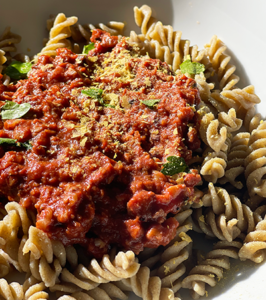 As a diabetes care and education specialist, I would say pasta is one of the main concerns from my clients and rightfully so!
As a diabetes care and education specialist, I would say pasta is one of the main concerns from my clients and rightfully so!
Typically, pasta dishes can have a lot of carbohydrates due to large portions and less ingredients such as protein, which helps slow down the digestion of the carbohydrates. Nevertheless, pasta is ALSO something that can be enjoyed by people living with diabetes. Like pizza, it’s about identifying the best strategy that works for you and is the most sustainable.
When it comes to vegetable pastas (zucchini and kohlrabi are some of my personal favorites), they can be beneficial to people living with diabetes for several reasons, including the lower carbohydrate and higher fiber. They can also be a great way to lower caloric intake for those focusing on weight management.
While a fantastic swap, it’s important to realize that these are not going to taste like traditional pastas. If you’re someone who doesn’t consume higher amounts of fiber on a regular basis, eating a huge plate of vegetables may cause stomach upset, which can cause some who try it to never try again. A way to fix this can be simply swapping out ⅓-½ of your traditional pasta for a veggie based one or more veggies.
Pastas made from legumes like beans and lentils often have high amounts of fiber and protein. With this being said, there are a few things to remember when it comes to these as well.
-
They don’t taste like traditional pasta. They can often be more dense, which some people may dislike.
-
They still have carbohydrates! As stated in previous posts, carbohydrates aren’t bad, but it is important to be mindful of portion sizes when planning meals as they will have the most impact on blood sugar levels. At times, people equate these alternative versions of foods as “healthier” and increase their portion sizes without being aware that it can still cause blood sugar to spike.
-
These are typically more expensive than traditional pastas.
Traditional pasta was one of the foods I didn’t eat for years post-diagnosis. It wasn’t until my education and the emergence of the technology that we have now, that I was able to revisit pasta. Successful ways to consume traditional pasta are adding more vegetables, lowering the amount of fat oils, butter, cheese sauces and meat sauces and monitoring portion sizes. If you’re dining out, combining these methods with your best dosing and movement strategy can help as well.
And one of my favorite ways to eat plant-based is pasta! You can get creative with your ingredients and make it as simple or complicated as you like. By incorporating a high fiber protein pasta, you are able to further amplify the blood sugar friendly benefits of the veggies.
While this recipe below is definitely intermediate to advanced, you can achieve a similar result by simply sauteing fresh mushrooms and adding them into already prepared store bought pasta sauce.
Download a Plant-Based Meat Sauce & Rotini Recipe (PDF)
Oatmeal
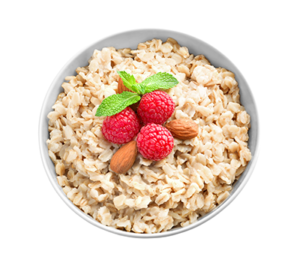 Oatmeal is often touted as one of the “best” foods for people living with diabetes. It has a high amount of fiber and is a source of prebiotics. Prebiotics act as fuel for our good gut bacteria and have been shown in studies to potentially aid with glycemic control. It is also one of the more common foods that my clients have found challenging.
Oatmeal is often touted as one of the “best” foods for people living with diabetes. It has a high amount of fiber and is a source of prebiotics. Prebiotics act as fuel for our good gut bacteria and have been shown in studies to potentially aid with glycemic control. It is also one of the more common foods that my clients have found challenging.
Similar to the foods mentioned above, the type of oatmeal and how you combine it with other foods determines your blood sugar response. Instant oats are more convenient, but are more processed which results in less fiber. They also can have more added sugar, which combined with lower fiber can lead to a spike in sugars.
Adding things like nuts, seeds, nut butters and protein packed Icelandic and Greek style yogurts can help to slow down digestion and keep you fueled longer than consuming two packets (which will double the carbohydrate). You can also choose an unsweetened or lower sugar instant oatmeal and control the amount of added sugar portion by adding your own dried fruits or fresh fruit.
Choosing less processed oat forms, such as steel cut oats and groats, will have a much higher fiber content than the instant and rolled oat form. These fiber filled types can be cooked or prepared ahead of time and chilled as overnight oats.
Now, you see why these foods are challenging and ways to make them a bit more manageable. Once you’re able to identify the blood sugar raising factors like high fat content, high added sugar content and low fiber content in these foods, you’ll be able to apply these diabetes detective tools to other foods that cause similar responses like desserts and foods when you are dining out.
Be sure to tag @Glooko or myself (@BalancedWithBridgetWood) on Instagram, and use the hashtags, #BetterTogether and #BalancedWithBridgetWood, in all of your blood-sugar-challenging to blood-sugar-balancing meal transformations!
Your Friend in Food,
Bridget Wood, RD, LD, CDCES
MKT-0412

 Alemania
Alemania  España
España  Francia
Francia